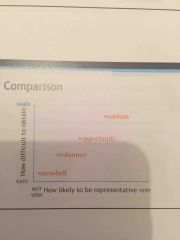![]()
![]()
![]()
Use LEFT and RIGHT arrow keys to navigate between flashcards;
Use UP and DOWN arrow keys to flip the card;
H to show hint;
A reads text to speech;
15 Cards in this Set
- Front
- Back
|
Population |
The group of people that results will apply to. |
|
|
Sampling |
Small group of people or things taken from a larger group and used to represent the larger group |
|
|
Random sampling |
Every member of the target population has an equal chance of being selected. Eg draw out a hat, electoral roll. |
|
|
Opportunity sampling |
Anyone who is available at the time of the study & agrees to take part can become a participant. |
|
|
Self-selected sampling |
Participants volunteer to take part in the study. |
|
|
Snowball sampling |
Is used when the population is not easy to contact. In this instance, a researcher may ask a participant who fits your target population to tell their friends about the study and ask them to get in touch with the researcher and more friends etc. |
|
|
Strength of random sampling |
-Unbiased/representative sample-generalise results -High in population validity |
|
|
Weaknesses of random sampling |
-Disliked to be chosen -Difficult to gain access to the names of all people |
|
|
Strength of opportunity sample |
-Quick & convenient way of obtaining participants -Useful for studying processes such as memory; thought to be similar for most people |
|
|
Weaknesses of opportunity sampling |
Biased sample |
|
|
Strength of self selected sampling |
-Unbiased -Ethical (informed consent) -Quick and convenient way of obtaining Ps (less drop outs) |
|
|
Weaknesses of self selected sampling |
-Volunteers may be outspoken -More demand characteristics -Unlikely to be representative |
|
|
Strength of snowball sampling |
-No lists exist (access to info) -Convenient and cost effective |
|
|
Weaknesses of snowball sampling |
-Unlikely to be representative because of bias nature of sample -The researcher may struggle to find one participant needed. |
|

|
Shows that the more difficult it is to obtain samples, the more likely it is to be representative |

